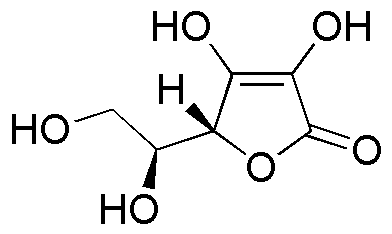L-Ascorbic acid is widely utilized in research focused on:
- Nutritional Supplements: Commonly found in vitamin C supplements, it supports immune function and skin health, making it essential for dietary formulations.
- Food Preservation: Acts as a natural antioxidant in food products, helping to prevent spoilage and maintain freshness, particularly in fruits and beverages.
- Cosmetic Formulations: Used in skincare products for its brightening properties and ability to reduce signs of aging, enhancing the efficacy of creams and serums.
- Pharmaceutical Applications: Plays a role in the synthesis of various drugs and is used in formulations to improve the stability and absorption of active ingredients.
- Biochemical Research: Serves as a reducing agent in laboratory experiments, aiding in the study of oxidative stress and cellular processes, which is crucial for advancing medical research.
General Information
Properties
Safety and Regulations
Applications
L-Ascorbic acid is widely utilized in research focused on:
- Nutritional Supplements: Commonly found in vitamin C supplements, it supports immune function and skin health, making it essential for dietary formulations.
- Food Preservation: Acts as a natural antioxidant in food products, helping to prevent spoilage and maintain freshness, particularly in fruits and beverages.
- Cosmetic Formulations: Used in skincare products for its brightening properties and ability to reduce signs of aging, enhancing the efficacy of creams and serums.
- Pharmaceutical Applications: Plays a role in the synthesis of various drugs and is used in formulations to improve the stability and absorption of active ingredients.
- Biochemical Research: Serves as a reducing agent in laboratory experiments, aiding in the study of oxidative stress and cellular processes, which is crucial for advancing medical research.
Documents
Safety Data Sheets (SDS)
The SDS provides comprehensive safety information on handling, storage, and disposal of the product.
Product Specification (PS)
The PS provides a comprehensive breakdown of the product’s properties, including chemical composition, physical state, purity, and storage requirements. It also details acceptable quality ranges and the product's intended applications.
Certificates of Analysis (COA)
Search for Certificates of Analysis (COA) by entering the products Lot Number. Lot and Batch Numbers can be found on a product’s label following the words ‘Lot’ or ‘Batch’.
*Catalog Number
*Lot Number
Certificates Of Origin (COO)
This COO confirms the country where the product was manufactured, and also details the materials and components used in it and whether it is derived from natural, synthetic, or other specific sources. This certificate may be required for customs, trade, and regulatory compliance.
*Catalog Number
*Lot Number
Safety Data Sheets (SDS)
The SDS provides comprehensive safety information on handling, storage, and disposal of the product.
DownloadProduct Specification (PS)
The PS provides a comprehensive breakdown of the product’s properties, including chemical composition, physical state, purity, and storage requirements. It also details acceptable quality ranges and the product's intended applications.
DownloadCertificates of Analysis (COA)
Search for Certificates of Analysis (COA) by entering the products Lot Number. Lot and Batch Numbers can be found on a product’s label following the words ‘Lot’ or ‘Batch’.
*Catalog Number
*Lot Number
Certificates Of Origin (COO)
This COO confirms the country where the product was manufactured, and also details the materials and components used in it and whether it is derived from natural, synthetic, or other specific sources. This certificate may be required for customs, trade, and regulatory compliance.


